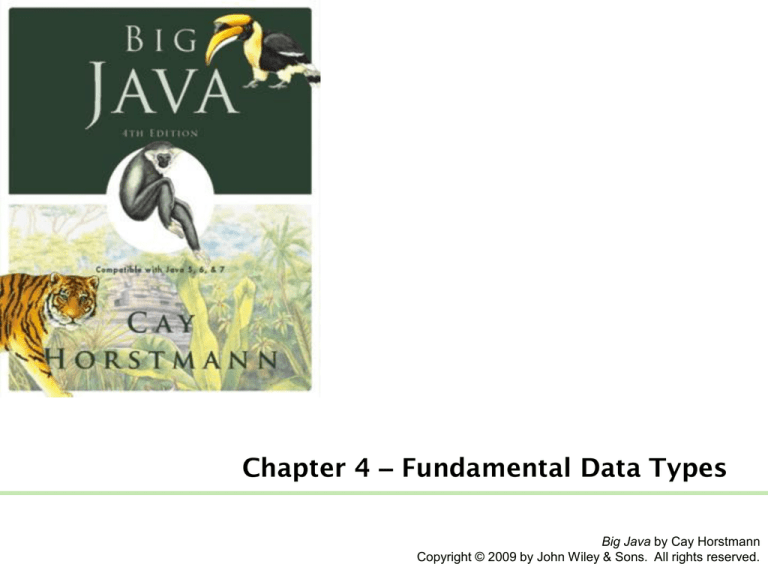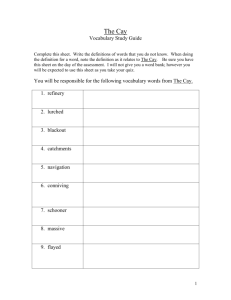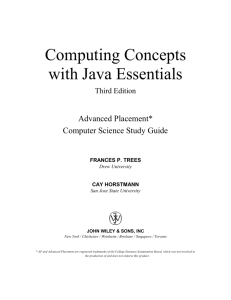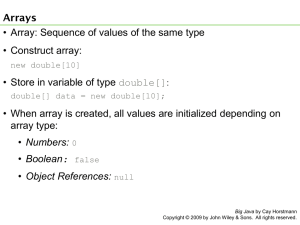
Chapter 4 – Fundamental Data Types
Big Java by Cay Horstmann
Copyright © 2009 by John Wiley & Sons. All rights reserved.
Chapter Goals
• To understand integer and floating-point numbers
• To recognize the limitations of the numeric types
• To become aware of causes for overflow and roundoff errors
• To understand the proper use of constants
• To write arithmetic expressions in Java
• To use the String type to define and manipulate character
strings
• To learn how to read program input and produce formatted
output
Big Java by Cay Horstmann
Copyright © 2009 by John Wiley & Sons. All rights reserved.
Number Types
• int: integers, no fractional part:
1, -4, 0
• double: floating-point numbers (double precision):
0.5, -3.11111, 4.3E24, 1E-14
• A numeric computation overflows if the result falls outside the
range for the number type:
int n = 1000000;
System.out.println(n * n); // prints -727379968
• Java: 8 primitive types, including four integer types and two
floating point types
Big Java by Cay Horstmann
Copyright © 2009 by John Wiley & Sons. All rights reserved.
Primitive Types
Type
Description
Size
int
The integer type, with range -2,147,483,648 . . . 2,147,483,647
4 bytes
byte
The type describing a single byte, with range -128 . . . 127
1 byte
short
The short integer type, with range -32768 . . . 32767
2 bytes
long
The long integer type, with range
-9,223,372,036,854,775,808 . . . 9,223,372,036,854,775,807
8 bytes
double
The double-precision floating-point type, with a range of about ±10308 and
about 15 significant decimal digits
8 bytes
float
The single-precision floating-point type, with a range of about ±1038 and
about 7 significant decimal digits
4 bytes
char
The character type, representing code units in the Unicode encoding
scheme
2 bytes
boolean
The type with the two truth values false and true
1 bit
Big Java by Cay Horstmann
Copyright © 2009 by John Wiley & Sons. All rights reserved.
Number Types: Floating-point Types
• Java: Illegal to assign a floating-point expression to an integer
variable:
double balance = 13.75;
int dollars = balance; // Error
Big Java by Cay Horstmann
Copyright © 2009 by John Wiley & Sons. All rights reserved.
Self Check 4.3
Which of the following initializations are incorrect, and why?
a. int dollars = 100.0;
b. double balance = 100;
Answer: The first initialization is incorrect. The right hand side
is a value of type double, and it is not legal to initialize an
int variable with a double value. The second initialization
is correct — an int value can always be converted to a
double.
Big Java by Cay Horstmann
Copyright © 2009 by John Wiley & Sons. All rights reserved.
Constants: final
• A final variable is a constant
• Once its value has been set, it cannot be changed
• Named constants make programs easier to read and maintain
• Convention: Use all-uppercase names for constants
final double QUARTER_VALUE = 0.25;
final double DIME_VALUE = 0.1;
final double NICKEL_VALUE = 0.05;
final double PENNY_VALUE = 0.01;
payment = dollars + quarters * QUARTER_VALUE
+ dimes * DIME_VALUE + nickels * NICKEL_VALUE
+ pennies * PENNY_VALUE;
Big Java by Cay Horstmann
Copyright © 2009 by John Wiley & Sons. All rights reserved.
Constants: static final
• If constant values are needed in several methods, declare them
together with the instance fields of a class and tag them as
static and final
• Give static final constants public access to enable other
classes to use them
public class Math
{
. . .
public static final double E = 2.7182818284590452354;
public static final double PI = 3.14159265358979323846;
}
double circumference = Math.PI * diameter;
Big Java by Cay Horstmann
Copyright © 2009 by John Wiley & Sons. All rights reserved.
Syntax 4.1 Constant Definition
Big Java by Cay Horstmann
Copyright © 2009 by John Wiley & Sons. All rights reserved.
ch04/cashregister/CashRegister.java
1
2
3
4
5
6
7
8
9
10
11
12
13
14
15
16
17
18
19
20
21
22
/**
A cash register totals up sales and computes change due.
*/
public class CashRegister
{
public static final double
public static final double
public static final double
public static final double
QUARTER_VALUE = 0.25;
DIME_VALUE = 0.1;
NICKEL_VALUE = 0.05;
PENNY_VALUE = 0.01;
private double purchase;
private double payment;
/**
Constructs a cash register with no money in it.
*/
public CashRegister()
{
purchase = 0;
payment = 0;
}
Continued
Big Java by Cay Horstmann
Copyright © 2009 by John Wiley & Sons. All rights reserved.
ch04/cashregister/CashRegister.java (cont.)
23
24
25
26
27
28
29
30
31
32
33
34
35
36
37
38
39
40
41
42
43
44
45
46
/**
Records the purchase price of an item.
@param amount the price of the purchased item
*/
public void recordPurchase(double amount)
{
purchase = purchase + amount;
}
/**
Enters the payment received from the customer.
@param dollars the number of dollars in the payment
@param quarters the number of quarters in the payment
@param dimes the number of dimes in the payment
@param nickels the number of nickels in the payment
@param pennies the number of pennies in the payment
*/
public void enterPayment(int dollars, int quarters,
int dimes, int nickels, int pennies)
{
payment = dollars + quarters * QUARTER_VALUE + dimes * DIME_VALUE
+ nickels * NICKEL_VALUE + pennies * PENNY_VALUE;
}
Continued
Big Java by Cay Horstmann
Copyright © 2009 by John Wiley & Sons. All rights reserved.
ch04/cashregister/CashRegister.java (cont.)
47
48
49
50
51
52
53
54
55
56
57
58
/**
Computes the change due and resets the machine for the next customer.
@return the change due to the customer
*/
public double giveChange()
{
double change = payment - purchase;
purchase = 0;
payment = 0;
return change;
}
}
Big Java by Cay Horstmann
Copyright © 2009 by John Wiley & Sons. All rights reserved.
ch04/cashregister/CashRegisterTester.java
1
2
3
4
5
6
7
8
9
10
11
12
13
14
15
16
17
18
19
20
21
22
23
24
/**
This class tests the CashRegister class.
*/
public class CashRegisterTester
{
public static void main(String[] args)
{
CashRegister register = new CashRegister();
register.recordPurchase(0.75);
register.recordPurchase(1.50);
register.enterPayment(2, 0, 5, 0, 0);
System.out.print("Change: ");
System.out.println(register.giveChange());
System.out.println("Expected: 0.25");
register.recordPurchase(2.25);
register.recordPurchase(19.25);
register.enterPayment(23, 2, 0, 0, 0);
System.out.print("Change: ");
System.out.println(register.giveChange());
System.out.println("Expected: 2.0");
}
}
Big Java by Cay Horstmann
Copyright © 2009 by John Wiley & Sons. All rights reserved.
ch04/cashregister/CashRegisterTester.java (cont.)
Program Run:
Change: 0.25
Expected: 0.25
Change: 2.0
Expected: 2.0
Big Java by Cay Horstmann
Copyright © 2009 by John Wiley & Sons. All rights reserved.
Self Check 4.4
What is the difference between the following two statements?
final double CM_PER_INCH = 2.54;
and
public static final double CM_PER_INCH = 2.54;
Answer: The first definition is used inside a method, the second
inside a class.
Big Java by Cay Horstmann
Copyright © 2009 by John Wiley & Sons. All rights reserved.
Self Check 4.5
What is wrong with the following statement sequence?
double diameter = . . .;
double circumference = 3.14 * diameter;
Answer:
1. You should use a named constant, not the “magic
number” 3.14.
Big Java by Cay Horstmann
Copyright © 2009 by John Wiley & Sons. All rights reserved.
Arithmetic Operators
• Four basic operators:
•
addition: +
•
subtraction: -
•
multiplication: *
•
division: /
• Parentheses control the order of subexpression computation:
(a + b) / 2
• Multiplication and division bind more strongly than addition and
subtraction:
(a + b) / 2
Big Java by Cay Horstmann
Copyright © 2009 by John Wiley & Sons. All rights reserved.
Increment and Decrement
• items++ is the same as items = items + 1
• items-- subtracts 1 from items
Big Java by Cay Horstmann
Copyright © 2009 by John Wiley & Sons. All rights reserved.
Integer Division
• / is the division operator
• If both arguments are integers, the result is an integer. The
remainder is discarded
• 7.0 / 4 yields 1.75
7 / 4 yields 1
• Get the remainder with % (pronounced “modulo”)
7 % 4 is 3
Big Java by Cay Horstmann
Copyright © 2009 by John Wiley & Sons. All rights reserved.
Integer Division
Example:
final
final
final
final
int
int
int
int
PENNIES_PER_NICKEL = 5;
PENNIES_PER_DIME = 10;
PENNIES_PER_QUARTER = 25;
PENNIES_PER_DOLLAR = 100;
// Compute total value in pennies
int total = dollars * PENNIES_PER_DOLLAR + quarters
* PENNIES_PER_QUARTER + nickels * PENNIES_PER_NICKEL
+ dimes * PENNIES_PER_DIME + pennies;
// Use integer division to convert to dollars, cents
int dollars = total / PENNIES_PER_DOLLAR;
int cents = total % PENNIES_PER_DOLLAR;
Big Java by Cay Horstmann
Copyright © 2009 by John Wiley & Sons. All rights reserved.
Powers and Roots
• Math class: contains methods sqrt and pow to compute
square roots and powers
• To compute xn, you write Math.pow(x, n)
• However, to compute x2 it is significantly more efficient simply
to compute x * x
• To take the square root of a number, use Math.sqrt; for
example, Math.sqrt(x)
• In Java,
can be represented as
(-b + Math.sqrt(b * b - 4 * a * c)) / (2 * a)
Big Java by Cay Horstmann
Copyright © 2009 by John Wiley & Sons. All rights reserved.
Analyzing an Expression
Big Java by Cay Horstmann
Copyright © 2009 by John Wiley & Sons. All rights reserved.
Mathematical Methods
Function
Returns
Math.sqrt(x)
square root
Math.pow(x, y)
power xy
Math.exp(x)
ex
Math.log(x)
natural log
Math.sin(x), Math.cos(x),
Math.tan(x)
sine, cosine, tangent
(x in radians)
Math.round(x)
closest integer to x
Math.min(x, y), Math.max(x, y)
minimum, maximum
Big Java by Cay Horstmann
Copyright © 2009 by John Wiley & Sons. All rights reserved.
Cast and Round
• Cast converts a value to a different type:
double balance = total + tax;
int dollars = (int) balance;
• Math.round converts a floating-point number to nearest
integer:
long rounded = Math.round(balance);
// if balance is 13.75, then rounded is set to 14
Big Java by Cay Horstmann
Copyright © 2009 by John Wiley & Sons. All rights reserved.
Syntax 4.2 Cast
Big Java by Cay Horstmann
Copyright © 2009 by John Wiley & Sons. All rights reserved.
Arithmetic Expressions
Big Java by Cay Horstmann
Copyright © 2009 by John Wiley & Sons. All rights reserved.
Self Check 4.8
Why doesn’t the following statement compute the average of s1,
s2, and s3?
double average = s1 + s2 + s3 / 3; // Error
Answer: Only s3 is divided by 3. To get the correct result, use
parentheses. Moreover, if s1, s2, and s3 are integers, you
must divide by 3.0 to avoid integer division:
(s1 + s2 + s3) / 3.0
Big Java by Cay Horstmann
Copyright © 2009 by John Wiley & Sons. All rights reserved.
Self Check 4.9
What is the value of
Math.sqrt(Math.pow(x, 2) + Math.pow(y, 2)) in
mathematical notation?
Answer:
Big Java by Cay Horstmann
Copyright © 2009 by John Wiley & Sons. All rights reserved.
Self Check 4.10
When does the cast (long) x yield a different result from the call
Math.round(x)?
Answer: When the fractional part of x is ≥ 0.5
Big Java by Cay Horstmann
Copyright © 2009 by John Wiley & Sons. All rights reserved.
Calling Static Methods
• A static method does not operate on an object
• Static methods are declared inside classes
• Naming convention: Classes start with an uppercase letter;
objects start with a lowercase letter:
Vehicle
mycar.fuelcap
Big Java by Cay Horstmann
Copyright © 2009 by John Wiley & Sons. All rights reserved.
Syntax 4.3 Static Method Call
Big Java by Cay Horstmann
Copyright © 2009 by John Wiley & Sons. All rights reserved.
The String Class
• A string is a sequence of characters
• Strings are objects of the String class
• A string literal is a sequence of characters enclosed in double
quotation marks:
"Hello, World!"
• String length is the number of characters in the String
• Example: "Harry".length() is 5
• Empty string: ""
Big Java by Cay Horstmann
Copyright © 2009 by John Wiley & Sons. All rights reserved.
Concatenation
• Use the + operator:
String name = "Dave";
String message = "Hello, " + name;
// message is "Hello, Dave"
• If one of the arguments of the + operator is a string, the other is
converted to a string
String a = "Agent”;
int n = 7;
String bond = a + n; // bond is "Agent7"
Big Java by Cay Horstmann
Copyright © 2009 by John Wiley & Sons. All rights reserved.
Concatenation in Print Statements
• Useful to reduce the number of System.out.print
instructions:
System.out.print("The total is ");
System.out.println(total);
versus
System.out.println("The total is " + total);
Big Java by Cay Horstmann
Copyright © 2009 by John Wiley & Sons. All rights reserved.
Converting between Strings and Numbers
• Convert to number:
int n = Integer.parseInt(str);
double x = Double.parseDouble(x);
• Convert to string:
String str = "" + n;
str = Integer.toString(n);
Big Java by Cay Horstmann
Copyright © 2009 by John Wiley & Sons. All rights reserved.
Substrings
• String greeting = "Hello, World!";
String sub = greeting.substring(0, 5); // sub is "Hello"
• Supply start and “past the end” position
• First position is at 0
Big Java by Cay Horstmann
Copyright © 2009 by John Wiley & Sons. All rights reserved.
Substrings
• String sub2 = greeting.substring(7, 12); // sub2 is "World"
• Substring length is “past the end” - start
Big Java by Cay Horstmann
Copyright © 2009 by John Wiley & Sons. All rights reserved.
Self Check 4.14
Assuming the String variable s holds the value "Agent", what
is the effect of the assignment s = s + s.length()?
Answer: s is set to the string Agent5
Big Java by Cay Horstmann
Copyright © 2009 by John Wiley & Sons. All rights reserved.
Self Check 4.15
Assuming the String variable river holds the value
"Mississippi ", what is the value of river.substring(1,
2)? Of river.substring(2, river.length() - 3)?
Answer: The strings "i" and "ssissi"
Big Java by Cay Horstmann
Copyright © 2009 by John Wiley & Sons. All rights reserved.
Reading Input
• System.in has minimal set of features — it can only read one
byte at a time
• In Java 5.0, Scanner class was added to read keyboard input in
a convenient manner
• Scanner in = new Scanner(System.in);
System.out.print("Enter quantity:");
int quantity = in.nextInt();
• nextDouble reads a double
• nextLine reads a line (until user hits Enter)
• next reads a word (until any white space)
Big Java by Cay Horstmann
Copyright © 2009 by John Wiley & Sons. All rights reserved.
ch04/cashregister/CashRegisterSimulator.java
1
2
3
4
5
6
7
8
9
10
11
12
13
14
15
16
17
18
19
20
import java.util.Scanner;
/**
This program simulates a transaction in which a user pays for an item
and receives change.
*/
public class CashRegisterSimulator
{
public static void main(String[] args)
{
Scanner in = new Scanner(System.in);
CashRegister register = new CashRegister();
System.out.print("Enter price: ");
double price = in.nextDouble();
register.recordPurchase(price);
System.out.print("Enter dollars: ");
int dollars = in.nextInt();
Continued
Big Java by Cay Horstmann
Copyright © 2009 by John Wiley & Sons. All rights reserved.
ch04/cashregister/CashRegisterSimulator.java (cont.)
21
22
23
24
25
26
27
28
29
30
31
32
33
34
System.out.print("Enter quarters: ");
int quarters = in.nextInt();
System.out.print("Enter dimes: ");
int dimes = in.nextInt();
System.out.print("Enter nickels: ");
int nickels = in.nextInt();
System.out.print("Enter pennies: ");
int pennies = in.nextInt();
register.enterPayment(dollars, quarters, dimes, nickels, pennies);
System.out.print("Your change: ");
System.out.println(register.giveChange());
}
}
Continued
Big Java by Cay Horstmann
Copyright © 2009 by John Wiley & Sons. All rights reserved.
ch04/cashregister/CashRegisterSimulator.java (cont.)
Program Run:
Enter price: 7.55
Enter dollars: 10
Enter quarters: 2
Enter dimes: 1
Enter nickels: 0
Enter pennies: 0
Your change: is 3.05
Big Java by Cay Horstmann
Copyright © 2009 by John Wiley & Sons. All rights reserved.
Self Check 4.16
Why can’t input be read directly from System.in?
Answer: The class only has a method to read a single byte. It
would be very tedious to form characters, strings, and numbers
from those bytes.
Big Java by Cay Horstmann
Copyright © 2009 by John Wiley & Sons. All rights reserved.
Self Check 4.17
Suppose in is a Scanner object that reads from System.in,
and your program calls
String name = in.next();
What is the value of name if the user enters John Q. Public?
Answer: The value is "John". The next method reads
the next word.
Big Java by Cay Horstmann
Copyright © 2009 by John Wiley & Sons. All rights reserved.







